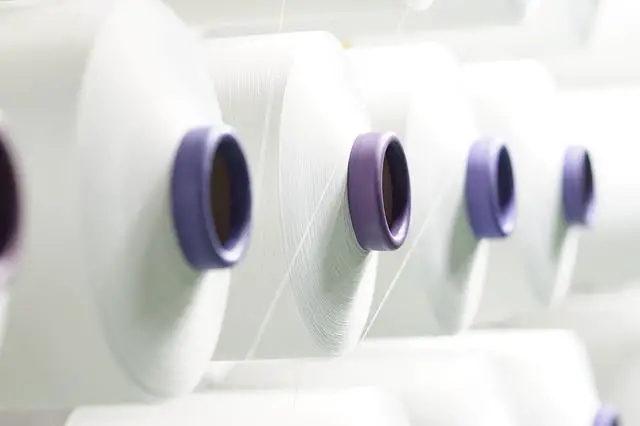In the guide below, we list and discuss some of the potential pros and cons of synthetic fibres.
It complements our separate guide on the potential pros and cons of natural fibres.
Summary – Pros & Cons Of Synthetic Fibres
Firstly, What Are Synthetic Fibres, & How Do They Compare To Other Types Of Fibres?
Potential Pros
Can Be Blended With Other Types Of Fibres
More Commonly Produced & Used Than Natural Fibres
Can Achieve Traits & Performance That Some Natural Fibres Might Not Be Able To
Longer Synthetic Filament Fibres Might Have Benefits Over Some Shorter Natural Staple Fibres For Some Applications
Can Be More Affordable Than Some Natural Fibres
Recycled Synthetic Fibre Exists
Plant Based Polyester Fibre Exists
Potential Cons
Usually Comes From Fossil Fuels
Some Natural Fibres May Have More Desirable Traits In Some Instances Than Synthetic Fibres
Tend To Always Involve The Use Of Chemicals At The Sourcing Stage
Can Have Other Sustainability Concerns
Even ‘Semi-Synthetic’ Fibres Aren’t Fully Natural
Can Release Plastic Based Microfibers
Plant Based Polyester Might Have Drawbacks
Other Notes
All fibres are produced by different brands and suppliers, and processed and used in textiles in different ways
Therefore, each individual fibre will have it’s own pros and cons, depending on variables to do with these aspects of fibres
The pros and cons in this guide are therefore generalized to an extent
Potential Pros Of Synthetic Fibres
Can Be Blended With Other Types Of Fibres
Synthetic fibres can be included in blends with other fibres to achieve desired traits in the end textile product
Polyester can be blended with cotton as one example
More Commonly Produced & Used Than Natural Fibres
Synthetic fibres are currently the most produced and most consumed fibre – more than natural fibres
Synthetic fibre production is also forecast to maintain or grow it’s market share in the future according to some reports.
Polyester is the most produced and consumed synthetic fibre.
Demand for polyester, the qualities and traits of polyester, and it’s affordability make it widely produced.
Can Achieve Traits & Performance That Some Natural Fibres Might Not Be Able To
Synthetic fibres can be engineered/designed and manufactured for certain desirable properties
As an example, some polyesters are more elastic, more water repellant, less prone to pilling and wrinkling, and easier to clean and maintain compared to some natural fibres
Some synthetic fibres can also be made to be stronger than some natural fibres
These traits and the performance of the fibre can also impact what it can be used for in it’s end use applications
Longer Synthetic Filament Fibres Might Have Benefits Over Some Shorter Natural Staple Fibres For Some Applications
As one example, longer and smoother filaments fibres might be used in silkier items of clothing and silkier textiles compared to some short natural fibres
Having said this, some natural fibres (like flax/linen for example) have short and longer fibres.
Can Be More Affordable Than Some Natural Fibres
Some polyesters are cheap to produce, and affordable for consumers
In comparison, some natural fibres can be more expensive to produce, and therefore more expensive for consumers too
Recycled Synthetic Fibre Exists
Such as recycled polyester
Plant Based Polyester Fibre Exists
For example, toray.com mentions that in plant based polyester, molasses left over from processing sugar cane can partially replace petroleum
Potential Cons Of Synthetic Fibres
Usually Comes From Fossil Fuels
Made from compounds derived from petrochemicals
Polyester is made from petroleum feedstock for example
Three considerations from this are:
Petrochemicals involve mining (instead of agriculture for growing plants, or rearing farming animals, that natural fibres might come from)
Petrochemicals are considered non-renewable
Synthetic fibres are impacted by supply issues and price changes with petrochemicals
Some Natural Fibres May Have More Desirable Traits In Some Instances Than Synthetic Fibres
For example, some natural fibres may have better absorbency and breathability than some synthetic fibres
Tend To Always Involve The Use Of Chemicals At The Sourcing Stage
Unlike natural fibres that can be grown and sourced from plants for example, synthetic fibres usually always require chemical reactions to make polymers before synthetic fibres can be created
Can Have Other Sustainability Concerns
We list some of the other potential sustainability concerns of some synthetic fibres in this guide
Even ‘Semi-Synthetic’ Fibres Aren’t Fully Natural
Semi-synthetic fibres come from plant based sources, but are modified by chemicals during the fibre forming or processing stage
Can Release Plastic Based Microfibers
As one example, synthetic fibres can break off in the washing machine, and find their way into the environment via discharged waste water
Plant Based Polyester Might Have Potential Drawbacks
For example, plant based polyester might still currently:
– Come from 30% sugar cane, and 70% petroleum
– Cost more than petroleum based polyester
– Be less durable than regular polyester
Sources
1. Various ‘Better Meets Reality’ guides
2. https://en.wikipedia.org/wiki/Synthetic_fiber
3. https://en.wikipedia.org/wiki/Fiber
4. https://www.toray.com/global/sustainability/articles/vol02.html
','' ); } ?>